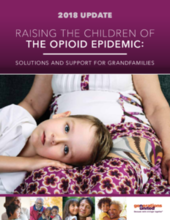Displaying 511 - 520 of 1759
The ninth International Foster Care Research Network Conference was held in September 2017 in Paris (France) on the theme ‘Continuity and disruption in foster care’. A selection of the presentations there were rewritten into a paper as part of this special issue.
This report from Generations United provides data on the opioid crisis in the US, and its impact on grandfamilies, and offers policy and program recommendations related to recently passed legislation - the Family First Prevention Services Act and the Supporting Grandparents Raising Grandchildren Act.
The objective of this evaluation was to provide evidence that can help strengthen performance and accountability with UNICEF’s work with the Royal Government of Cambodia and the myriad other authorities and organizations involved in child protection.
This study linked Child and Family Services (CFS), Justice, and Population Health Registry data to quantify the overlap between having a history of CFS during childhood (0-17 years) and being charged with a crime as a youth (12-17 years).
This scoping study yielded 37 empirical studies published in peer-reviewed journals addressing one of the most pressing, sensitive, and controversial issues facing child welfare policymakers and practitioners today: the dramatic overrepresentation of Indigenous families in North American public child welfare systems.
In this paper, the authors examine if and how care order proceedings could be improved in England, Finland, Norway, and California, USA, asking the judiciary decision‐makers about their views on what should be improved.
This article demonstrates how structural social work theory and critical consciousness development can be used to help facilitate a transition from a deficit model approach to an inequities perspective in a child welfare system that was working to improve the identification of and services for domestic minor sex trafficked youth (DMST).
In this chapter children’s rights and state obligations in relation to alternative care are presented, with reference to the UN Alternative Care Guidelines and the general comments and concluding observations of the UN Committee on the Rights of the Child.
Focused on the UK, this chapter considers the relevance of human rights in relation to children who are deprived of their liberty by the state on ‘welfare’ grounds for their own or others’ protection.
This chapter provides an overview of the German child protection system.



